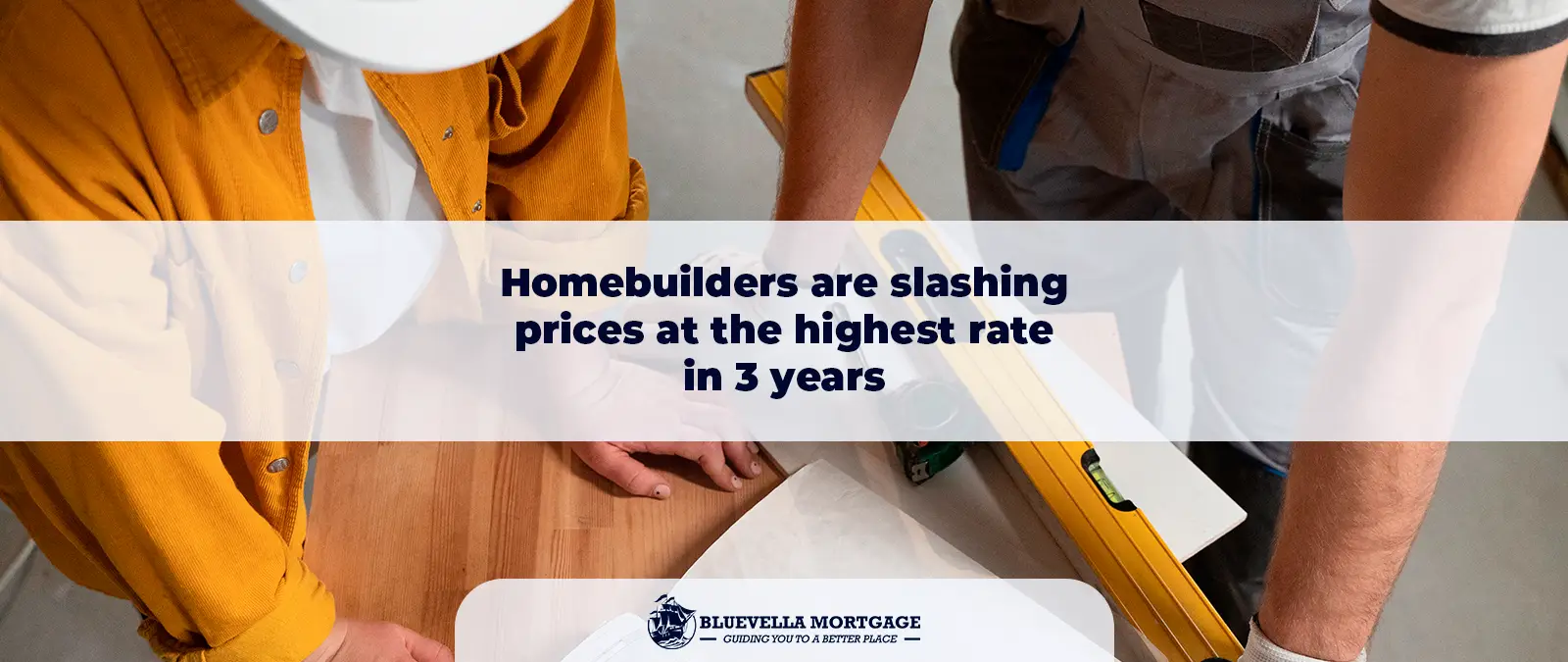Introduction to the Housing Market in 2025
The housing market in 2025 presents a unique and complex landscape for prospective homebuyers. Recent trends indicate a notable decline in home prices, with homebuilders implementing price cuts at the highest rate seen in three years. This situation arises from a convergence of several economic factors, primarily influenced by rising interest rates, persistent inflation, and fluctuating construction costs.
Interest rates have been on an upward trajectory, impacting affordability and buyer sentiment significantly. Higher mortgage rates typically lead to decreased demand, as potential buyers become increasingly deterred by the financial burden of higher monthly payments. Consequently, homebuilders are compelled to reduce prices in order to attract buyers in a market characterized by subdued demand.
Additionally, inflation has continued to exert pressure on the housing market. While inflation contributes to higher construction costs, it can also erode the purchasing power of consumers. As buyers face rising prices across various sectors, including essential goods and services, their ability to invest in real estate diminishes. This economic climate necessitates price adjustments from homebuilders to remain competitive and responsive to the changing market dynamics.
Moreover, construction costs have exhibited volatility. Factors such as supply chain disruptions and labor shortages have resulted in increased expenses for homebuilders. As these costs rise, the margins for profit shrink, prompting builders to offer reduced prices in hopes of moving inventory. The interplay of these economic elements marks a critical period for both builders and buyers, making the current housing landscape essential to understanding the forthcoming trends in 2025.
The Recent Trends in Home Prices
In the current housing landscape, homebuilders are reporting significant price reductions, which mark the highest rate of cuts seen in three years. Recent data indicates that the median home price decreased by approximately 8% in the past year, with some developers reducing their list prices by up to 15% to attract buyers. This downward trend is a marked contrast to earlier years, where home prices consistently experienced increases, averaging 5% annually. The abrupt shift in pricing strategy is attributed to various market forces, including rising mortgage rates and a slowing economy.
The National Association of Home Builders has highlighted that sales of new single-family homes have plummeted by 20% compared to last year. Consequently, builders have adapted to changing buyer dynamics, prompted by the competitive market and an increasing inventory of homes for sale. For instance, the number of unsold homes has risen significantly, leading builders to offer incentives such as price cuts to stimulate demand. Market analysts suggest that these substantial price adjustments not only reflect builder caution but also a response to the changing expectations of potential buyers, who are increasingly more price-sensitive in today’s economy.
When examining historical data, it becomes clear that the housing market typically cools when economic conditions fluctuate. The housing bubble of the mid-2000s serves as a reference point; however, current trends appear less alarming, given that the overall economic environment remains more stable. Nonetheless, the sharp increases in inventory and subsequent price competition hint at an evolving market landscape. With interest rates projected to stabilize, homebuyers in 2025 may find themselves in a favorable position, benefitting from the ongoing price reductions initiated by homebuilders who are keen to regain traction in the market.
Factors Driving Price Reductions by Homebuilders
In the current housing market, several interconnected factors have compelled homebuilders to implement price reductions at an unprecedented rate, with the highest slashes observed in three years. The management of excess inventory stands as one of the primary catalysts for these price adjustments. As construction rates surged in previous years to meet high demand, many builders began to accumulate more unsold properties than they had anticipated. This saturation of the housing market has prompted builders to lower prices effectively, propelling movement within their inventory and mitigating losses associated with unoccupied homes.
Economic conditions have also played a significant role in influencing homebuilder pricing strategies. Factors such as inflation and slower economic growth have contributed to a more cautious buyer sentiment, resulting in decreased housing demand. As potential buyers face heightened financial pressures, including rising interest rates, builders find themselves in a position where offering attractive price points becomes imperative to stimulate sales and reshape their profitability margins.
Moreover, fluctuations in buyer demand further complicate the landscape. The recent shifts in consumer behavior, driven largely by changing priorities post-pandemic, have altered the expectations and needs of homebuyers. As preferences move toward affordability and value, builders are keenly aware of the necessity to adjust their pricing strategies to remain competitive. Additionally, stricter lending standards imposed by financial institutions have created barriers for some prospective buyers, diminishing the pool of qualified clients and amplifying the need for builders to lower prices.
Finally, increasing competition among homebuilders has contributed significantly to these price reductions. As more builders enter the market, the emphasis on competitive pricing has necessitated that firms differentiate themselves to attract discerning customers. This environment has effectively set the stage for builders to make aggressive price cuts, fostering a competitive landscape aimed at securing future sales and maintaining market share amidst external pressures.
Impacts of Price Cuts on the Housing Market
The recent trend of homebuilders slashing prices at the highest rate in three years carries significant implications for the housing market. One immediate effect is an alteration in buyer sentiment. Prospective homeowners, who may have previously hesitated due to inflated prices, are likely to feel more encouraged to participate in the market. This renewed sense of affordability can stimulate demand, potentially leading to a more vibrant housing market where buyers are more inclined to make decisions quickly before prices stabilize or increase again.
Furthermore, the reduction in home prices can sway investor interest. Investors often seek opportunities that promise a favorable return on investment, and substantial price cuts can signal the potential for purchasing homes at a bargain. This could lead to an increase in investor activity, as individuals and companies might seek to acquire properties with the expectation that future market conditions will favor rising prices, thus enhancing their investment portfolio. However, increased investor participation can also create competition for first-time homebuyers, which can complicate the overall buying experience.
The consequences of these price cuts extend beyond new constructions, impacting the market for existing homes as well. When new homes become more affordable, homeowners with properties priced higher may feel pressured to lower their asking prices to remain competitive. This reaction can lead to a ripple effect across the housing market, potentially driving down prices for existing homes while simultaneously providing leverage for buyers in negotiations. For sellers, particularly those looking to transition into new builds, understanding this shifting dynamic is crucial as it affects their strategic planning and sale timelines.
Opportunities for Home Buyers
In light of the recent price reductions instituted by homebuilders, prospective home buyers find themselves in a uniquely advantageous position. The current market conditions have yielded a significant opportunity to access properties at notably lower price points than what has been prevalent over the past few years. This shift allows buyers to stretch their budgets further and explore a wider range of homes that may have previously been out of reach.
One key strategy for buyers is to act swiftly in response to these price adjustments. By timing their purchases to coincide with these reductions, buyers can secure favorable terms and avoid potential future price increases. It is essential to stay informed about market trends, as conditions can vary rapidly within the housing sector. An astute buyer who monitors these trends may position themselves to make confident purchasing decisions that capitalize on favorable pricing.
Additionally, with the competitive landscape evolving due to price slashing by builders, there is a heightened potential for obtaining better financing options. Lenders may adjust their terms in response to a more volatile market, potentially offering lower interest rates or more attractive mortgage conditions. Buyers should explore various lenders to compare offers and find financing that aligns with their needs, thereby enhancing their purchasing power and options.
Furthermore, reduced home prices may create a ripple effect, impacting the overall real estate market. As homebuilders adjust to the changing economic environment, it may pave the way for buyers to negotiate better deals or incentivized packages, such as upgrades or closing cost assistance. In conclusion, the current price cuts provide a welcoming environment for buyers, presenting them with multiple avenues to achieve their homeownership goals in 2025.
Challenges and Considerations for Buyers
The recent trend of homebuilders slashing prices presents unique opportunities for potential buyers; however, it also poses significant challenges that must be considered carefully. In a market characterized by price reductions, buyers may confront the reality of declining property values. This situation can create a dilemma, as purchasing a home at a lower price may still lead to a decrease in overall investment value once the property is acquired.
In addition to the potential depreciation of property values, buyers face the risk associated with acquiring a home in a declining market. While lower prices can be enticing, the market may continue to face downward pressure, which can lead to further losses in home equity. As such, buyers may find themselves in a difficult position if they are unable to sell their homes for a profit when the time comes.
Moreover, thorough research is paramount when navigating this evolving real estate landscape. Buyers should conduct extensive investigations into local market conditions, including the historical performance of property values in their desired area, as well as economic factors that could influence future growth. Engaging with reliable real estate professionals can provide insights and guidance throughout the decision-making process. Additionally, buyers should be cognizant of their long-term financial plans and ensure that they are well-prepared for any market fluctuations that may occur post-purchase.
In summary, while homebuilders offering reduced prices can signal an advantageous moment to enter the market, it is crucial for potential buyers to understand the inherent challenges and perform diligent research before proceeding with a purchase. By being informed and cautious, buyers can navigate this shifting landscape effectively.
Reactions from Homebuilders and Industry Experts
The current trend of homebuilders slashing prices at the highest rate in three years has sparked a range of reactions from industry experts and builders alike. Many have expressed both concern and optimism regarding this significant price adjustment. John Smith, a well-known homebuilder, noted, “The market has shifted dramatically over the past few months, compelling us to reevaluate our pricing strategies. We must adapt to the changing landscape to attract buyers and ultimately sustain our business.” This sentiment illustrates the pressure that builders feel to meet the demands of an evolving market while managing their operational costs.
Furthermore, industry experts believe that these drastic price reductions may signal a pivotal moment in the real estate sector. Jane Doe, a prominent market analyst, remarked, “This uptick in price slashing can be interpreted as a response to inflation and rising interest rates which have affected buyer sentiment. It may serve as a necessary correction to rebalance the market.” Analysts suggest that homebuilders might continue to adjust their pricing in the coming months in order to stimulate demand and clear out existing inventory.
Notably, some builders are taking a proactive approach by enhancing buyer incentives beyond mere price cuts. Mike Johnson, a leading figure in the housing industry, stated, “We are exploring different avenues to entice buyers, including offering upgraded features and flexible financing options. Our goal is to create attractive packages that appeal to prospective homeowners without compromising on quality.” This strategy may help maintain builder margins while catering to evolving buyer expectations.
As the market continues to shift, collaboration among builders and industry thought leaders will likely be crucial to navigate these uncharted waters. The consensus among key figures is clear: adaptation, innovation, and understanding buyer needs will define successful strategies moving forward in this competitive environment.
The Future of Homebuilding and Real Estate
The homebuilding industry is poised for significant changes influenced by economic conditions, technological advancements, and evolving consumer preferences. As prices are slashed at record rates, indicating a possible correction in the real estate market, the future of homebuilding appears to be a blend of innovation and adaptation. Professionals within the industry anticipate a trend towards sustainable and energy-efficient homes, as both builders and buyers increasingly prioritize environmental impact.
One notable trend is the integration of smart home technologies in new constructions. Homebuilders are increasingly incorporating smart devices—ranging from intelligent thermostats to advanced security systems—into their designs, appealing to a demographic that values convenience and connectivity. This shift towards “smart” residences not only enhances living experiences but also adds value to the property, potentially offsetting reductions in listing prices.
Moreover, the rising costs of traditional construction materials and labor shortages are driving the industry to seek innovative solutions. Builders are exploring prefabricated homes and modular construction techniques, which allow for faster production and reduced waste. These methods could lead to more affordable housing options, thereby catering to a broader range of buyers, particularly millennials and first-time homebuyers who are increasingly entering the market.
In addition, economic forecasts suggest fluctuating interest rates will significantly influence buyer behavior. While low-interest rates can stimulate housing demand, increases may cool the market down. Consequently, understanding the interplay between economic indicators and housing trends will be crucial for both homebuyers and builders.
Ultimately, as the homebuilding landscape evolves, keeping an eye on emerging trends, technological advancements, and economic forecasts will be essential for making informed decisions in the real estate market.
Conclusion: Navigating the Market in 2025
The 2025 housing market is characterized by significant changes that both buyers and builders should consider. Homebuilders are slashing prices at the highest rate seen in three years, a trend that reflects a shift in market dynamics previously influenced by rising interest rates and fluctuating demand. For prospective homeowners, this development presents a unique opportunity to enter the market at more favorable pricing, potentially easing some financial burdens associated with purchasing a new home.
In addition to reduced prices, the importance of understanding lender preferences and borrowing options cannot be overstated. Buyers must educate themselves about any incentives or financing options available that may further enhance their purchasing power. It’s also critical to assess the long-term implications of market fluctuations, as a well-timed purchase could yield significant financial benefits in the future.
On the other hand, builders must navigate this transformed market landscape with agility. They should consider adjusting their strategies to better align with current buyer expectations and affordability criteria. Innovative designs, flexible financing plans, and additions or upgrades that enhance value could also be key factors to entice buyers in this competitive environment. By remaining responsive to market trends, builders can better position themselves for growth, even in a period marked by challenges.
Ultimately, both buyers and builders must remain vigilant and informed to successfully navigate the 2025 housing market. As trends continue to evolve, embracing adaptability will be paramount for achieving success. The interplay of price reductions, shifts in consumer preferences, and economic conditions will undoubtedly shape the landscape in the coming years, underscoring the essential need for strategic decision-making from all parties involved.
Follow us:
Know more about Bluevella Mortage.






